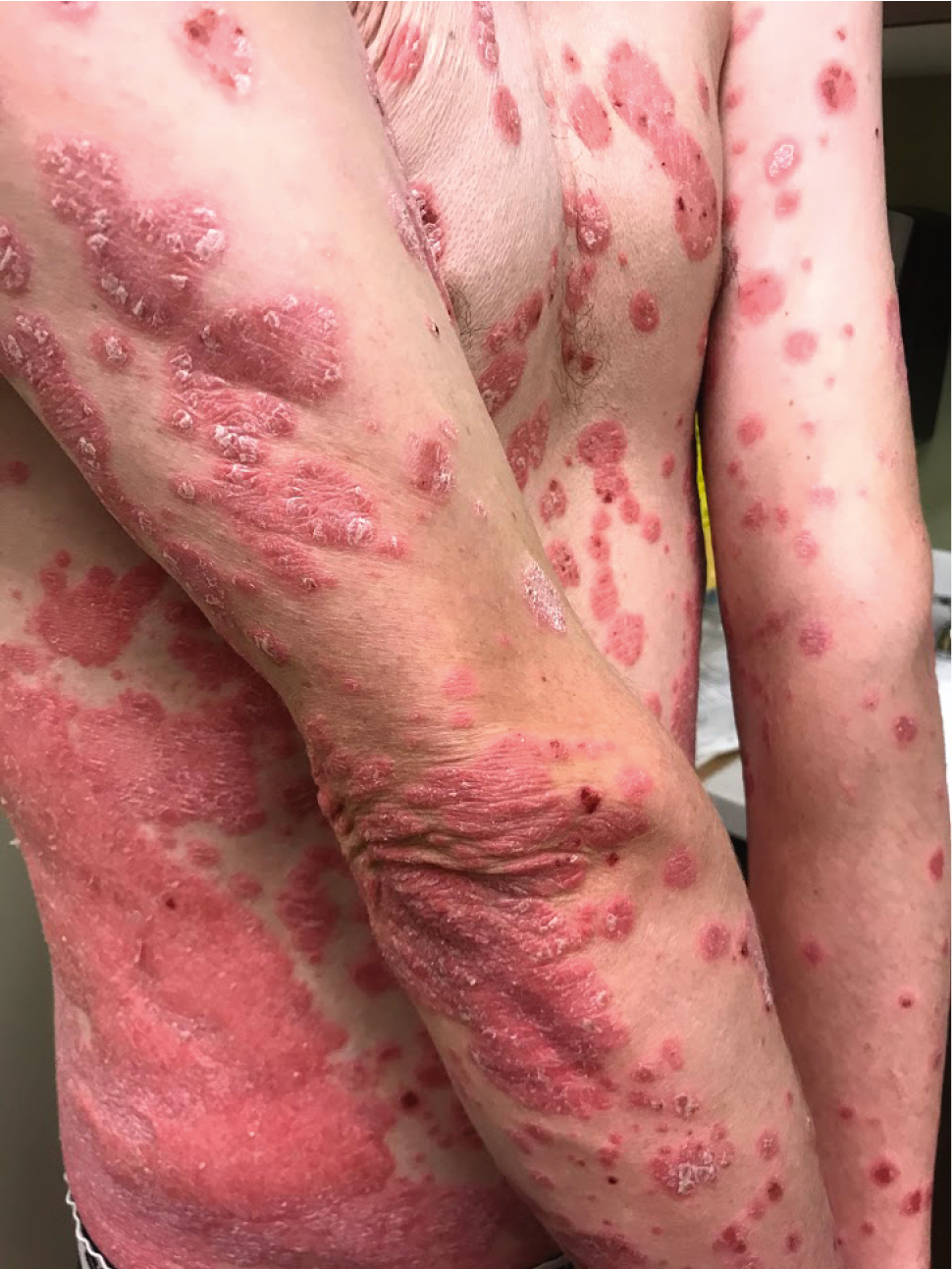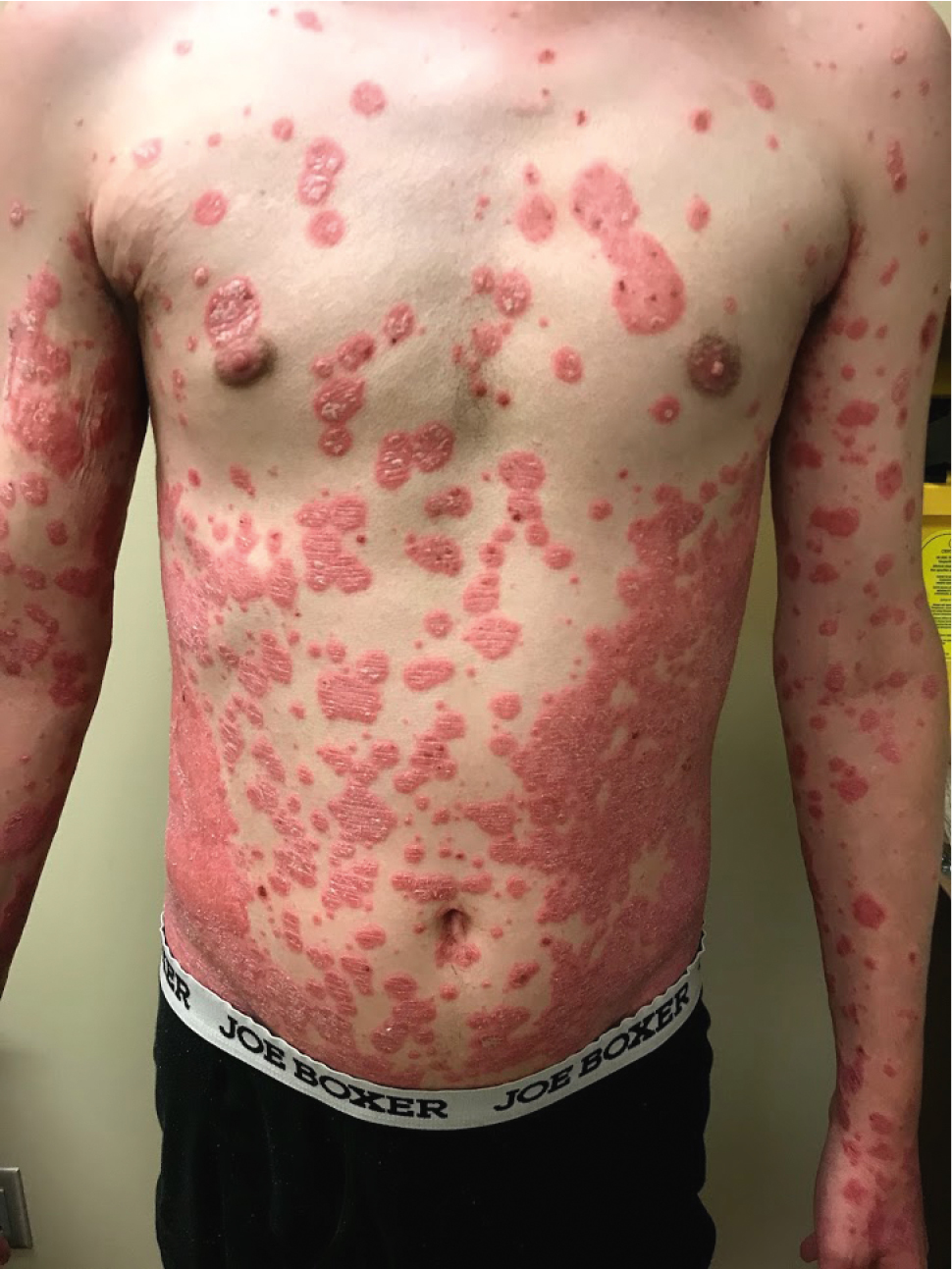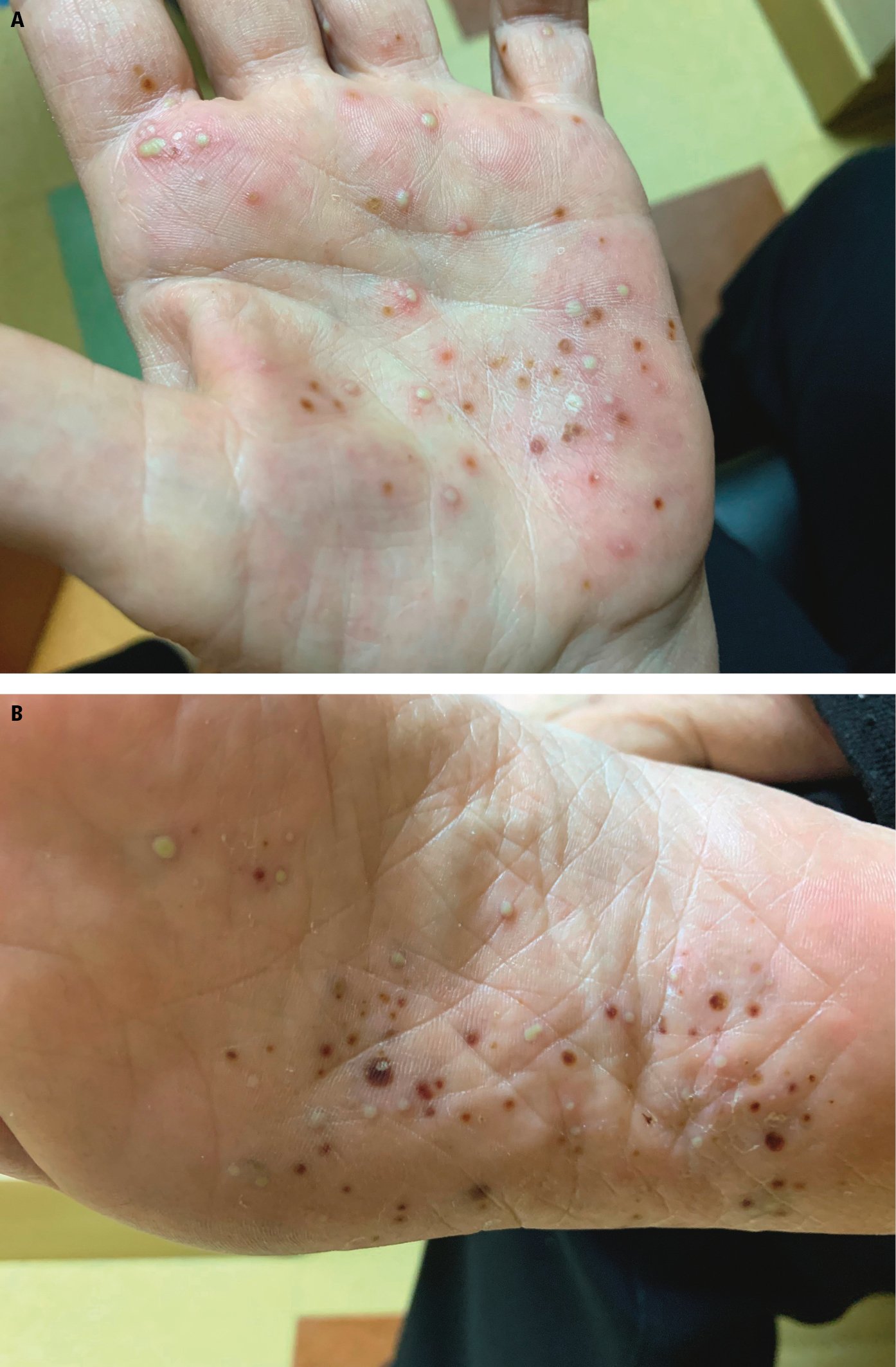Menter A, Gelfand JM, Connor C, et al. Joint American Academy of Dermatology-National Psoriasis Foundation guidelines of care for the management of psoriasis with systemic nonbiologic therapies. J Am Acad Dermatol. 2020 Jun;82(6):1445-1486. doi: 10.1016/j.jaad.2020.02.044. Epub 2020 Feb 28. PMID: 32119894.
Elmets CA, Lim HW, Stoff B, et al. Joint American Academy of Dermatology-National Psoriasis Foundation guidelines of care for the management and treatment of psoriasis with phototherapy. J Am Acad Dermatol. 2019 Sep;81(3):775-804. doi: 10.1016/j.jaad.2019.04.042. Erratum in: J Am Acad Dermatol. 2020 Mar;82(3):780. PMID: 31351884.
Menter A, Strober BE, Kaplan DH, et al. Joint AAD-NPF guidelines of care for the management and treatment of psoriasis with biologics. J Am Acad Dermatol. 2019 Apr;80(4):1029-1072. doi: 10.1016/j.jaad.2018.11.057. Epub 2019 Feb 13. PMID: 30772098.
Definition, Etiology, PathogenesisTop
Psoriasis is a chronic immune-mediated inflammatory disease affecting 1% to 3% of the population worldwide. The pathogenesis of psoriasis is complex and polygenic; current evidence indicates that tumor necrosis factor (TNF)-alpha and interleukin (IL) 23/Th17 pathways are crucial.
Psoriasis can also be induced by drugs. Several drugs have been linked to the induction of psoriasis, such as lithium, interferons, beta-blockers, and antimalarial drugs (eg, hydroxychloroquine and chloroquine). Despite being highly effective for psoriasis, TNF-alpha inhibitors can paradoxically induce psoriasis or psoriasiform dermatitis when used for treatment of inflammatory bowel disease, rheumatoid arthritis, or other chronic inflammatory conditions.
Clinical Features and Natural HistoryTop
Psoriasis has a wide spectrum of clinical manifestations. There are 5 major types of psoriasis:
1. Chronic plaque psoriasis: This is the most common type of psoriasis, characterized by well-defined erythematous plaques with overlying white-silvery scales. Areas of predilection include the elbows, knees, and lower back (Figure 4.5-1, Figure 4.5-2). Psoriasis can also involve areas such as the scalp, genitalia, and nails. Nail changes include pitting, subungual hyperkeratosis, onycholysis (Figure 4.5-3), leukonychia, and splinter hemorrhages.
2. Guttate psoriasis is characterized by an acute eruption of multiple fine-scaled, small papules (usually sized <1 cm), typically on the trunk and proximal extremities. It is often preceded by streptococcal pharyngitis, tonsillitis, or less commonly by perianal streptococcal disease.
3. Inverse psoriasis (also known as intertriginous or flexural psoriasis): This type of psoriasis affects intertriginous areas such as the groin and axillae and is characterized by well-defined erythematous plaques and patches that often lack the characteristic scaling due to the moisture in these areas.
4. Pustular psoriasis:
1) Generalized: Acute generalized pustular psoriasis (GPP), also known as the Von Zumbusch type, is a rare but severe variant. It is characterized by an acute onset of widespread pustules and systemic complications such as fever, malaise, arthralgia, and leukocytosis. Known triggers include hypocalcemia, withdrawal of systemic steroids, infections, and drugs. When it occurs in pregnancy, it is called pustular psoriasis of pregnancy or impetigo herpetiformis.
2) Localized: There are 2 well-known patterns of localized psoriasis: palmoplantar pustulosis (Figure 4.5-4) and acrodermatitis continua of Hallopeau.
5. Erythrodermic psoriasis: Erythroderma, also known as generalized exfoliative dermatitis, can be caused by psoriasis. It is characterized by diffuse, confluent erythema and scaling covering large areas of the skin. While some references use 75% body surface area (BSA) involvement as a cutoff point, others consider 90%.
1. Psoriatic arthritis: Approximately 10% to 30% of patients with psoriasis develop psoriatic arthritis. Psoriatic arthritis may precede, follow, or occur simultaneously with skin manifestations.
2. Cardiovascular disease and metabolic syndrome: Psoriasis is associated with an increased risk of metabolic syndrome (obesity, dyslipidemia, and impaired fasting blood glucose levels) and cardiovascular disease.
3. Depression: Psoriasis is associated with increased risk of depression and increased psychosocial burden. Quality of life is often highly impacted by psoriasis.
4. Inflammatory bowel disease: Patients with psoriasis are at increased risk of Crohn disease and ulcerative colitis.
5. Malignancy: Patients with psoriasis appear to be at a slightly increased risk of developing hematologic (eg, lymphomas), skin, and solid cancers.
DiagnosisTop
The diagnosis of psoriasis is primarily clinical, and skin biopsy is rarely needed. Differential diagnosis includes pityriasis rubra pilaris, dermatitis, pityriasis rosea, subcorneal pustular dermatosis, and drug eruptions. When the clinical presentation is atypical, skin biopsy can be very helpful. Histopathologic findings include acanthosis, epidermal psoriasiform hyperplasia with elongation of the rete ridges and thinning of suprapapillary plates, and hypogranulosis. The papillary dermis shows mild edema, dilated capillaries, and lymphocytic infiltrate.
TreatmentTop
Patients should be educated about the natural chronic course of the disease and advised on frequent use of emollients. Treatment should be individualized taking into consideration its availability as well as the severity and extent of the disease, patient age, medical comorbidities, and possible contraindications to certain systemic or biologic therapies. Patients with severe psoriasis have poor quality of life and increased morbidity. However, with recent advances in treatment options and availability of biologic therapies, the prognosis of psoriasis has markedly improved. Phototherapy and systemic and biologic therapy should be provided by a dermatologist, rheumatologist, or internist experienced in the management of psoriasis.
The treatment of psoriasis depends mostly on the severity and extent of the disease. Assessment of the severity of psoriasis is crucial. In the clinic, BSA is the most widely used tool for the measurement of skin involvement and can be easily estimated. The National Psoriasis Foundation defines mild psoriasis as <3% BSA; moderate psoriasis as 3% to 10% BSA; and severe psoriasis as >10% BSA. Many other scoring systems are available to assess disease severity or its effect on patients’ quality of life. The most widely used scores are the Physician Global Assessment (PGA), the Psoriasis Area and Severity Index (PASI; mdcalc.com), and the Dermatology Life Quality Index (DLQI) (bad.org.uk). PGA and PASI scores are assigned by physicians, while the DLQI is reported by patients.
Mild disease is typically treated with topical therapy. Topical treatments can be prescribed by primary care providers. Indications for ultraviolet and systemic or biologic therapy, usually delivered by a clinician specializing in this condition, include failure to respond to topical therapy, facial, genital, or palmoplantar involvement, and moderate to severe disease, especially if >10% BSA and PASI of ≥10 are reported. It is important to remember that psoriasis can be severe irrespective of BSA involvement when it affects certain areas such as the hands or genitals, when it causes exceptional pruritus, or when it has a serious emotional impact for the patient.
Rebound psoriasis and worsening of psoriasis after withdrawal of systemic glucocorticoids is a well-established phenomenon. Therefore, these drugs should be avoided.
1. Moisturizers: This category includes occlusive moisturizers, emollients, and humectants. Occlusive moisturizers create a physical barrier helping to trap moisture and seal water in the skin. Emollients have mild sealing properties to keep water inside the skin and soften it. Humectants attract water to the skin making it soft and moist.
2. Topical glucocorticoid creams and ointments (betamethasone valerate 0.1%, betamethasone dipropionate, clobetasol propionate 0.05%).
3. Topical vitamin D analogues such as calcipotriene (calcipotriol) available in Canada as an ointment and cream (50 microg/g).
4. Combination of topical glucocorticoids and vitamin D analogues: A combination of calcipotriene (calcipotriol; 50 microg/g) and betamethasone dipropionate (0.5 mg/g) is available in Canada as a gel and foam.
5. Combination of topical glucocorticoids and topical retinoids: A combination of tazarotene (0.045%) and halobetasol propionate (0.01%) is available in Canada as a lotion for the treatment of plaque psoriasis.
6. Calcineurin inhibitors: Tacrolimus ointment (0.03% or 0.1%) and pimecrolimus (available in Canada as 1% cream) are steroid-free agents and are very useful for facial and genital psoriasis where potent topical steroids should absolutely be avoided.
7. Topical roflumilast (0.3%) is the first topical phosphodiesterase-4 (PDE4) inhibitor to be approved for the treatment of psoriasis, including in skin folds.
Phototherapy and Photochemotherapy
These therapies are mostly available in academic institutions and should be operated only under supervision of a dermatologist. Different types of phototherapy are available for psoriasis:
1) Narrowband ultraviolet B (UVB) phototherapy.
2) Broadband UVB phototherapy.
3) Oral or bath psoralen plus ultraviolet light in the A range (PUVA) photochemotherapy: Psoralens are photosensitive drugs that absorb ultraviolet and cause cell apoptosis.
Conventional drugs include acitretin, methotrexate, and oral cyclosporine (Table 4.5-1).
Apremilast is an oral PDE4 inhibitor approved for the treatment of moderate to severe psoriasis and psoriatic arthritis. The recommended dose is 30 mg bid. Adverse effects are mostly related to the gastrointestinal (GI) tract and include nausea, diarrhea, and weight loss. Advantages of apremilast include its lack of immunosuppression and good safety profile. Also, no prescreening tests or ongoing laboratory monitoring are required.
Deucravacitinib is an oral tyrosine kinase 2 inhibitor indicated for moderate to severe psoriasis. Unlike apremilast, deucravacitinib requires prescreening for tuberculosis and viral hepatitis. Advantages of deucravacitinib include its tolerability, once-daily dosing, and lack of adverse GI effects.
Biologic agents such as TNF-alpha inhibitors, IL-12/23 inhibitors, IL-17 inhibitors, and IL-23 inhibitors can be used. The choice depends on the presence or absence of psoriatic arthritis, other medical comorbidities, patient age, and drug availability (Table 4.5-2).
Biosimilars are now available for adalimumab and ustekinumab. They are designed to match the original biologic medications in terms of safety, efficacy, and quality. The availability of these biosimilars provides an opportunity to access biologic therapies at a reduced cost without compromising treatment outcomes.
Treatment of Generalized Pustular Psoriasis
Spesolimab is a monoclonal antibody against interleukin-36 receptor (IL-36R) and approved for the treatment of GPP. For the treatment of GPP flare, spesolimab is administered as a single IV dose of 900 mg. If the flare persists, an additional dose of 900 mg may be given one week after the initial dose. For maintenance therapy in patients without an active flare, treatment begins with a loading dose of 600 mg administered subcutaneously, followed by a maintenance dose of 300 mg subcutaneously every 4 weeks. Adverse effects include injection-site reactions, pruritus, headache, and fatigue.
Tables and FiguresTop
|
Agent |
Dosage |
Adverse effects |
Special considerations |
|
Acitretin (oral retinoid) |
10-25 mg/d PO |
– Dry skin and mucous membranes – Retinoid dermatitis – Elevated liver enzymes – Hyperlipidemia – Teratogenicity |
Requires regular monitoring of liver function and lipids (usually every 3-4 months) |
|
Methotrexate (folate antagonist) |
7.5-25 mg/wk PO or SC |
– Nausea, vomiting, and GI upset – Fatigue – Cytopenia – Mucositis – Hair loss – Hepatotoxicity – Increased risk of infections |
– Requires regular monitoring of blood count and liver and kidney function (usually monthly for the first 3 months, then every 3-4 months) – Possible drug–drug interaction – Supplementation with folic acid may reduce certain adverse effects |
|
Cyclosporine (calcineurin inhibitor) |
3-5 mg/kg/d PO |
– Electrolyte imbalance (eg, hyperkalemia and hypomagnesemia) – Hyperuricemia – Dyslipidemia – Hypertension – Neurotoxicity (eg, headache, tremor, and peripheral neuropathy) – Nephrotoxicity – Hypertrichosis – Gingival hyperplasia – Increased risk of infection – Increased risk of malignancy |
– Requires regular blood count monitoring (usually monthly for the first 3 months, then every 3-4 months) – Possible drug–drug interaction |
|
GI, gastrointestinal; PO, oral; SC, subcutaneous. |
|||
|
Agenta |
Class |
Dosage |
Adverse effects |
|
Etanercept |
TNF-alpha inhibitor |
50 mg SC twice weekly for 12 weeks, then 50 mg every week |
– Injection-site reaction – Increased risk of upper and lower respiratory tract infection – TB and hepatitis B reactivation – Increased risk of malignancy and lymphomas – Drug-induced lupus – Demyelinating disease – Worsening of heart failure |
|
Adalimumab |
TNF-alpha inhibitor |
80 mg SC at week 0, 40 mg at week 1, and then 40 mg every 2 weeks |
– Injection-site reaction – Increased risk of upper and lower respiratory tract infection – TB and hepatitis B reactivation – Increased risk of malignancy and lymphomas – Drug-induced lupus – Demyelinating disease – Worsening of heart failure |
|
Infliximab |
TNF-alpha inhibitor |
5 mg/kg IV at weeks 0, 2, and 6, and then every 12 weeks |
– Infusion reactions – Increased risk of upper and lower respiratory tract infection – TB and hepatitis B reactivation – Increased risk of malignancy and lymphomas – Drug-induced lupus – Demyelinating disease – Worsening of heart failure |
|
Certolizumab pegol |
TNF-alpha inhibitor |
400 mg SC every 2 weeks |
– Injection-site reaction – Increased risk of upper and lower respiratory tract infection – TB and hepatitis B reactivation – Increased risk of malignancy and lymphomas – Drug-induced lupus – Demyelinating disease – Worsening of heart failure |
|
Ustekinumab |
IL-12/23 inhibitor |
45 mg (weight <100 kg) or 90 mg (weight >100 kg) SC at weeks 0 and 4, then the same dose every 12 weeks |
– Injection-site reaction – Increased risk of upper respiratory tract infection – Headache |
|
Secukinumab |
IL-17 inhibitor |
300 mg SC at weeks 0, 1, 2, 3, and 4, then every 4 weeks (up to every 2 weeks for weight >90 kg) |
– Injection-site pain and reaction – Increased risk of infection with Candida spp – Neutropenia – IBD |
|
Ixekizumab |
IL-17 inhibitor |
160 mg SC at week 0, followed by 80 mg at weeks 2, 4, 6, 8, 10, and 12, then 80 mg every 4 weeks |
– Injection-site pain and reaction – Increased risk of infection with Candida spp – Neutropenia – IBD |
|
Brodalumab |
IL-17 inhibitor |
210 mg SC at weeks 0, 1, and 2, and then every 2 weeks |
– Injection-site pain and reaction – Increased risk of infection with Candida spp – Neutropenia – IBD – Depression and suicidal ideation |
|
Bimekizumab |
IL-17 inhibitor |
320 mg SC (given as 2 injections of 160 mg each) at weeks 0, 4, 8, 12, 16, and every 8 weeks thereafter |
– Injection-site reaction – Increased risk of fungal infection including Candida infections – Increased risk of nasopharyngitis and upper respiratory tract infection – Headache – Diarrhea |
|
Guselkumab |
IL-23 inhibitor |
100 mg SC at weeks 0 and 4, and every 8 weeks thereafter |
– Injection-site reaction – Increased risk of upper respiratory tract infection |
|
Risankizumab |
IL-23 inhibitor |
150 mg SC at weeks 0 and 4, and every 12 weeks thereafter |
– Injection-site reaction – Increased risk of upper respiratory tract infection |
|
Tildrakizumab |
IL-23 inhibitor |
100 mg SC at weeks 0 and 4, and every 12 weeks thereafter |
– Injection-site reaction – Increased risk of upper respiratory tract infection |
|
Apremilast |
PDE4 inhibitor |
30 mg PO bid |
– Nausea – Diarrhea – Weight loss – Headache |
|
Deucravacitinib |
TYK2 inhibitor |
6 mg PO once a day |
– Dyslipidemia – Increased risk of infections |
|
a Baseline screening for latent TB and hepatitis B and C is recommended before initiation of treatment with any of these agents, except apremilast. |
|||
|
bid, twice daily; IBD, inflammatory bowel disease; IL, interleukin; PDE4, phosphodiesterase 4; PO, oral; TB, tuberculosis; TNF, tumor necrosis factor; SC, subcutaneous; spp, species; TYK2, tyrosine kinase 2. |
|||

Figure 4.5-1. Plaque-type psoriasis with well-defined erythematous plaques with whitish-silvery scales. Photograph courtesy of Dr Mohannad Abu-Hilal.

Figure 4.5-2. Diffuse plaque-type psoriasis. Photograph courtesy of Dr Mohannad Abu-Hilal.

Figure 4.5-3. Onycholysis in a patient with plaque psoriasis. Photograph courtesy of Dr Mohannad Abu-Hilal.

Figure 4.5-4. Palmoplantar pustulosis. A, palmar pustulosis. B, plantar pustulosis. Photograph courtesy of Dr Mohannad Abu-Hilal.